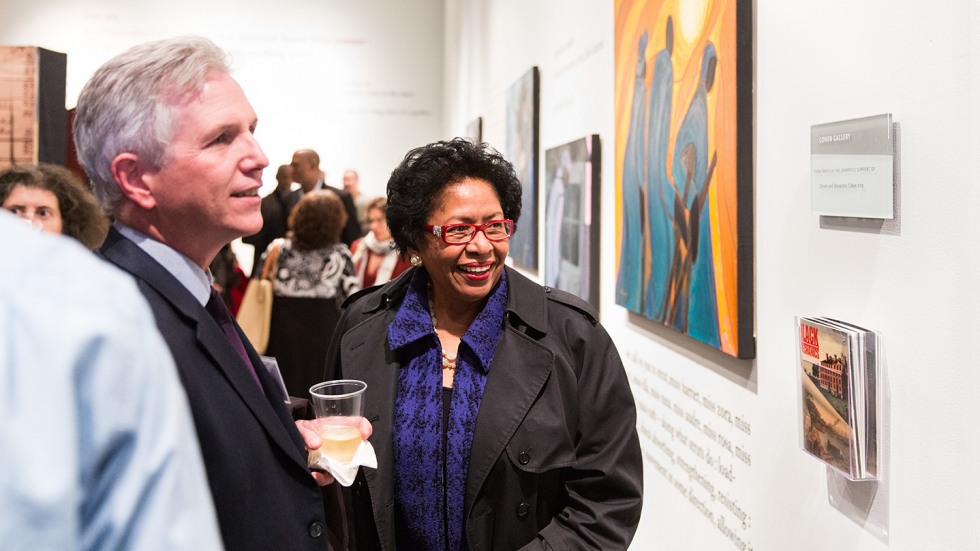PROVIDENCE, R.I. [Brown University] — Ten years after the release of a groundbreaking report commissioned under her leadership to explore the involvement of Brown University’s early benefactors in the slave trade, President Emerita Ruth J. Simmons returned to Providence to open a three-day conference, “Slavery and Global Public History: New Challenges,” with a keynote address on Dec. 1 that emphasized the critical importance of truth-telling and the need to do so with a clear purpose.
In her address, titled “Universities and the Problem of Slavery,” Simmons spoke about how as president, “barely three generations removed from [her] slave ancestors,” she would see the portrait of the University’s first president, James Manning, a slave owner, and consider that continuum. “We live and study among many artifacts,” Simmons said, and we can “whitewash histories of sordid racism” or “mistake moral faults for virtue.”
Simmons said the Slavery and Justice effort at Brown — launched in 2003 when she appointed a steering committee to study the relationship between the slave trade and the founding of the University— was driven by “the simple aim to teach us about ourselves. But ultimately, it “opened up the world to what the University is” — a place of critical thought where the community can “constantly reassess what our aims are as a nation and strive toward that.”
The goal of the project at Brown, which sparked conversations across institutions of higher education, was not to bring shame to one group and power to another, Simmons said, but to “talk about how we share in a human condition. The question is not what malefactors did two centuries ago. We need to know about it, we need to bring it to light, but the question is: What are we doing about it?”
Brown’s Center for the Study of Slavery and Justice, host to this weekend’s conference, is itself an outgrowth of the effort initiated under Simmons’s leadership. The center’s director, Barrymore A. Bogues, said that through work in the public humanities, the conference attendees — scholars, curators, university and public officials and public historians from all over the world — contend with the complexity of interpreting slavery and its legacies, an endeavor taken up by an increasing number of institutions over the past two decades.
“One of the most vexed issues of politics, history and memory at the present time is that of racial slavery and the ways its legacies continue to shape our national institutions today,” Bogues said. “This conference attempts to grapple with these issues at a moment when deep reflection is called for both in America and the world as old ideas about race, long thought to be dead and buried, have remerged with force and passion.”
This weekend’s conference also marks 10 years since Brown University and Yale University’s Gilder Lehrman Center for the Study of Slavery, Resistance and Abolition hosted an international symposium on slavery and public history, an event the Gilder Lehrman Center’s director, David W. Blight, described as “inchoate, complex, but amazing.”
In the years since Brown’s 2006 report, a growing number of universities have launched efforts to explore their connections to slavery. As work in the field has evolved, at universities and beyond, new questions have arisen. The conference’s panels and presentations encompass a multitude of questions and challenges, something that Brown President Christina Paxson acknowledged in opening the second day of the conference.
“This is what universities should be doing,” Paxson said, emphasizing the importance of rigorous research and higher education’s unique role in expanding ways of knowing that “perhaps, if we do a good job, position us to effect change.”
Paxson said that in her role as an economist studying social health and economic disparities, particularly in New Orleans after Hurricane Katrina, she saw “raw and visible racial disparities” on display in the disaster’s aftermath. While some were not surprised to see people of color suffering disproportionately, because those structural disparities are part of the legacy of slavery, Paxson said, others asked, “’How can the world still be like this?’” adding that the courage and conviction to effect change is needed now more than ever.
Blight said acknowledging the past “seems simple on the surface, but it never is… There is far more public memory than public history that we write.”
Simmons, in her keynote and in a question-and-answer session that followed, stressed the need for continued action in the present. “You can’t go back and redo history,” she said. “But you can be responsible for what you do today… Excellence is built on truth-telling — and not on lies and secrets.”
The conference concludes tomorrow, Dec. 3. A related exhibition, “Black Mechanics: The Making of an American University and a Nation,” is on view at the Granoff Center’s Cohen Gallery through Dec. 21.
The conference is co-sponsored by Brown’s Center for the Study of Slavery and Justice, Yale’s Gilder Lehrman Center and the Smithsonian’s National Museum of African American History and Culture. Additional support was provided by the University’s John Nicholas Brown Center for Public Humanities and Cultural Heritage.


